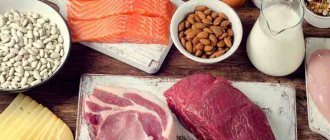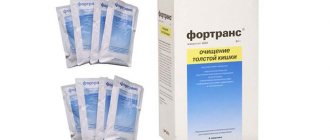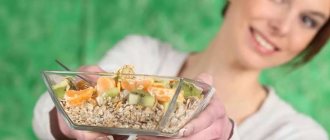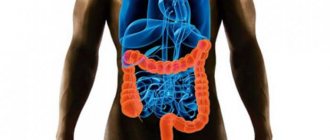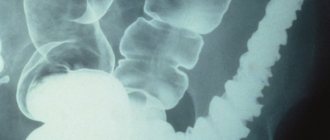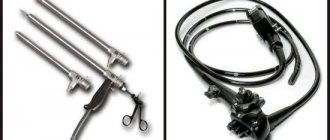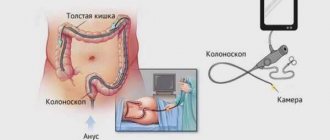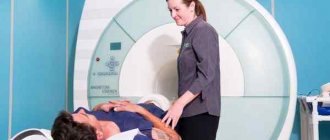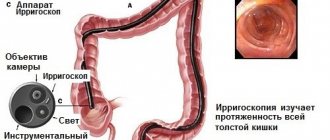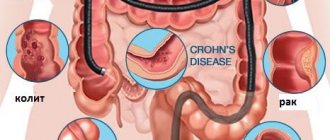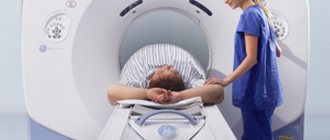The need for a diet before colonoscopy
In modern diagnostic and treatment practice, the colonoscopy technique remains one of the most reliable and informative ways to identify various diseases of the large intestine.
Thanks to real-time visualization of the intestinal lumen, it is possible to detect pathological changes in the mucous membrane, erosive and ulcerative lesions, polyps, benign and malignant neoplasms, as well as areas of bleeding. A slag-free diet is an integral part of preliminary preparation for this type of examination. By following dietary recommendations, it is possible to cleanse the intestinal lumen from remnants of undigested food, mucus and other foreign elements that can impair the quality of visualization of the mucous membrane. In addition, a slag-free diet inhibits the process of gas formation, which also has a positive effect on the quality of diagnostics. The combined use of medicinal or mechanical methods of intestinal cleansing and a slag-free diet allows you to obtain the most reliable and complete information about the state of the intestinal lumen during colonoscopy.
The purpose of bowel cleansing before the procedure
People go on a slag-free diet not only before a colonoscopy. It is no less important for the results of irrigoscopy, MRI, computed tomography, and ultrasound examination of the abdominal cavity.
Its main goal is to prepare the intestines so that they are perfectly clean and completely free of feces; it is advisable that a specialist rate it 9 points on the Boston scale. It is necessary not only to get rid of feces, but also to achieve a stable state of the mucous membranes and intestinal microflora. After all, during a colonoscopy, the doctor may decide to perform surgical manipulation or take tissue for further examination. And in this case, the walls of the organ must be dry and clean.
It is these issues that the slag-free diet solves, which significantly reduces the volume of feces and facilitates cleansing activities.
Read more about how to prepare for a colonoscopy in the article >>>
Authorized Products
There is a separate list of food ingredients, the use of which will not adversely affect the quality of colonoscopy diagnostics. It is necessary to create a daily diet taking into account those foods that will be listed below. Such products include:
- Cereals: corn, oat flakes, rice, buckwheat, millet.
- Dairy and fermented milk products: homemade kefir or yogurt, low-fat cottage cheese, tofu cheese, ricotta, gouda, Adyghe cheese, feta cheese.
- Vegetable ingredients: pumpkin pulp, zucchini, onions, carrots, red beets, broccoli or cauliflower. In addition, corn, potatoes and daikon are allowed in minimal quantities. It is recommended to cook vegetable dishes baked, stewed, or steamed.
- Meat ingredients: rabbit, chicken, venison, turkey, veal or beef. The listed types of meat are recommended to be baked or stewed.
- Seafood and fish ingredients: flounder, milk hake, perch, pike perch, saury, blue whiting, cod, pollock, scallops, mussels, squid and shrimp.
- Egg products. It is permissible to consume chicken or quail eggs, soft-boiled or poached, in small quantities.
- Herbs and greens: cilantro, celery leaves, dill, green onions, parsley, basil.
- Fruit and berry ingredients: bananas, strawberries, strawberries, pears, apples, citrus fruits, melons, blackberries, blueberries, apricots and peaches.
- Groceries: bread made from wholemeal wheat flour, pasta made from durum wheat, crackers from wheat bread, diet or biscuits, muesli without adding nuts and dried fruits.
- Spices and seasonings: cinnamon, turmeric, coriander, fresh ginger root.
- Drinks: mineral water without carbon dioxide, chicory root drink, fruit and berry compote diluted with water 1:1, freshly squeezed fruit and berry juices, weak black or green tea, and hibiscus.
- Oil: it is allowed to add flaxseed, sunflower or olive oil to prepared dishes in small quantities.
Partially limited products
There is also a separate list of foods that may not be completely excluded while following a diet, but their consumption may be limited to a minimum. Such products include:
- non-concentrated broths from vegetables, meat and fish;
- semolina and homemade wholemeal noodles;
- sugar, honey;
- butter;
- fruit and berry jelly.
Preparing for colonoscopy using Fortrans
For a successful intestinal examination, not only diet is important, but also preliminary cleansing of the gastrointestinal tract using laxatives. One of the popular drugs is Fortrans.
The active ingredient of the laxative is polyethylene glycol (macrogol). By binding water molecules, the drug increases the volume of fluid in the intestinal lumen, which helps to increase the volume of intestinal contents, soften them and make bowel movements easier.
Macrogol is not metabolized in the body, is not absorbed into the blood, and is excreted unchanged. Contraindications for the use of Fortrans: age under 15 years, intestinal obstruction. At the beginning of taking the drug, nausea and vomiting are possible, which disappear when drinking subsequent portions.
List of prohibited products
Below is a list of foods that are completely excluded from the daily diet during preparation for a colonoscopy examination of the large intestine. The following ingredients are prohibited:
- Cereals: pearl barley, peas, wheat, rice and barley.
- Vegetable ingredients and greens: red and white cabbage, garlic, sorrel, lettuce, spinach.
- Egg products: chicken and quail eggs, hard-boiled or fried until fried.
- Dairy and fermented milk products: kefir and yogurt (fat percentage more than 2.5%), full-fat cottage cheese, hard cheeses with 20% fat content or more (Parmesan, Edam, Russian, Dutch).
- Fish ingredients: halibut, mackerel, herring, catfish, beluga, sterlet, salmon, pink salmon, trout, chum salmon, sturgeon, saury.
- Meat ingredients: pork fat and lard, duck and goose meat, fatty beef, lamb and pork. In addition, strong meat and bone broths are prohibited.
- Berries: raspberries, black currants, grapes, gooseberries.
- Groceries: noodles and pasta made from premium wheat flour, bread made from rye flour, yeast and puff pastries.
- Confectionery and sweets: pastries and cakes, sweets, chocolate, marmalade, preserves, jam.
- Sauces and seasonings: wasabi, adjika, tkemali, paprika sauce, red and black ground pepper, mustard, garlic sauces.
- Drinks: any types of alcohol, drinks with added carbon dioxide, coffee, strong black tea, freshly squeezed fruit and berry juices with pulp, cocoa, kvass.
- Canned foods: corn, meat, poultry, fish, beans, peas.
- Other products: all types of mushrooms, mayonnaise and ketchup, nuts, store-bought semi-finished products, fast food, salted, pickled and pickled vegetables, sausages and sausages, all types of smoked meats.
Slag-free diet menu before colonoscopy
A slag-free diet before performing a colonoscopy is distinguished by its simplicity and lack of harm to the human body. The daily menu before a colonoscopy should be compiled individually, taking into account the gastronomic preferences of the person. An important condition for such a diet is the presence in the daily diet of fermented milk products with a low percentage of fat content, fruits and vegetables in baked or boiled form.
3-2 days before colonoscopy
During the first 2-3 days of following a slag-free diet before performing a colonoscopy, the daily diet may look like this:
- Breakfast. 1 glass of chicory root drink, 150 g of low-fat cottage cheese with 2 tablespoons of yogurt or a few pieces of peach.
- Lunch. 2-3 pcs. biscuits and 250 ml of homemade kefir with a low fat content.
- Dinner. A weak chicken broth, boiled rice, 1 slice of wholemeal wheat bread, cauliflower puree and a small slice of boiled chicken breast.
- Afternoon snack. A sandwich made from a slice of wholemeal bread, a cucumber and a piece of feta cheese or hard cheese, 1 glass of weak green tea.
- Dinner. Steamed rice cereal, chicken or beef steamed meatballs, 1 glass of low-fat homemade kefir.
1 day before colonoscopy
When there are a day left before the test, the menu for the whole day may look like this:
- Breakfast. 250 ml fruit juice without pulp, 1 soft-boiled chicken egg.
- Lunch. 1-2 baked apples without added sugar and honey, 250 ml of homemade low-fat yogurt or kefir.
- Lunch: 2-3 wheat bread crackers, 200 ml of weak chicken broth, 1 glass of weak green tea and homemade fruit jelly.
- Afternoon snack. 250 ml low-fat kefir, 150 g banana puree.
- Dinner. 200 ml of weak chicken breast broth, 1 glass of chamomile flower tea.
After dinner, on the eve of the day of the colonoscopy, a person is allowed to drink only water.
Meals on the day of your colonoscopy
Directly on the day of performing a colonoscopic examination of the intestines, any food intake is excluded before the procedure. The day before this diagnostic procedure, it is recommended to drink at least 1.5 liters of clean water, including juices, broths, tea and fermented milk drinks. If the patient will be examined under general anesthesia, the last intake of water should be taken 6 hours before the diagnostic procedure. If the procedure is performed without the use of anesthesia, then drinking water is allowed 2-3 hours before the start of the procedure.
In addition, on the day of the colonoscopy, it is not recommended to take any pharmaceuticals. Taking medications is allowed only for those patients who suffer from arterial hypertension or severe diseases of the cardiovascular system. 4 hours before the diagnosis, the patient is recommended to take Duphalac or Fortrans in order to completely empty the lumen of the large intestine. If on the day of diagnosis the patient’s stool has a dark, cloudy color, this indicates incorrect adherence to the slag-free diet. Such patients are recommended to postpone diagnosis and undergo preliminary preparation again.
Quality assessment according to the Boston scale
Before performing a colonoscopy, the doctor can evaluate the quality of bowel cleansing using the Boston scale, which provides a 9-point rating scale, where the best indicator is 9.
All segments of the intestine are examined separately, their condition is assessed from 0 to 3, and the points are summed up.
Priced separately:
- left sections, which include the rectum, descending and sigmoid colon;
- colon with angles;
- the right part, including the ascending and cecum.
Scale results:
- Each department receives 0 points if it is completely unprepared for examination, its mucous membrane is practically not visible due to feces;
- 1 point if the internal walls are covered with feces, opaque liquid or foam;
- 2 points – there are minor remains of excrement or foam;
- 3 points – the mucous membrane is in a dry and clean state, completely visible without difficulty.
The examination can begin if the patient scores 6 or higher on the Boston scale.
